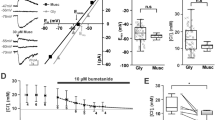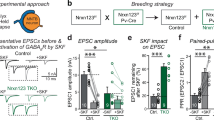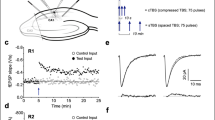Abstract
Activity-induced long-term modification of glutamatergic synapses depends on the frequency of synaptic activation. We found that long-term modification of developing rat hippocampal GABAergic synapses that was induced by repetitive coincident pre- and postsynaptic spiking was also frequency dependent. Spiking at 20–50 Hz resulted in synaptic potentiation, whereas spiking at 5 Hz led to synaptic depression. The potentiation was abolished by blocking GABAB receptors (GABABRs), whereas the depression was independent of GABABR activation and could be converted to potentiation by elevating GABABR activity. The potentiation could be attributed to a local postsynaptic increase in Na+/K+/2Cl− co-transporter activity near activated synapses. The activity of postsynaptic Ca2+/calmodulin-dependent protein kinase II was necessary for long-term potentiation of these developing GABAergic synapses and its phosphorylation at Thr286 could be enhanced by activating GABABRs with baclofen. Together with our finding that activation of GABABRs is frequency dependent, these results indicate that postsynaptic GABABR activation mediates frequency-dependent potentiation of developing GABAergic synapses.
This is a preview of subscription content, access via your institution
Access options
Subscribe to this journal
Receive 12 print issues and online access
$209.00 per year
only $17.42 per issue
Buy this article
- Purchase on Springer Link
- Instant access to full article PDF
Prices may be subject to local taxes which are calculated during checkout







Similar content being viewed by others
References
Katz, L.C. & Shatz, C.J. Synaptic activity and the construction of cortical circuits. Science 274, 1133–1138 (1996).
Bliss, T.V. & Collingridge, G.L. A synaptic model of memory: long-term potentiation in the hippocampus. Nature 361, 31–39 (1993).
Martin, S.J., Grimwood, P.D. & Morris, R.G. Synaptic plasticity and memory: an evaluation of the hypothesis. Annu. Rev. Neurosci. 23, 649–711 (2000).
Malenka, R.C. & Siegelbaum, S.A. Synaptic plasticity: diverse targets and mechanisms for regulating synaptic efficacy. in Synapses (eds. Cowan, W.M., Sudhof, T.C. & Stevens, C.F.) 393–453 (Johns Hopkins University Press, Baltimore, Maryland, 2001).
Malenka, R.C. & Bear, M.F. LTP and LTD: an embarrassment of riches. Neuron 44, 5–21 (2004).
Gaiarsa, J.L., Caillard, O. & Ben-Ari, Y. Long-term plasticity at GABAergic and glycinergic synapses: mechanisms and functional significance. Trends Neurosci. 25, 564–570 (2002).
Ben-Ari, Y., Gaiarsa, J.L., Tyzio, R. & Khazipov, R. GABA: a pioneer transmitter that excites immature neurons and generates primitive oscillations. Physiol. Rev. 87, 1215–1284 (2007).
Kano, M., Rexhausen, U., Dreessen, J. & Konnerth, A. Synaptic excitation produces a long-lasting rebound potentiation of inhibitory synaptic signals in cerebellar Purkinje cells. Nature 356, 601–604 (1992).
Aizenman, C.D., Manis, P.B. & Linden, D.J. Polarity of long-term synaptic gain change is related to postsynaptic spike firing at a cerebellar inhibitory synapse. Neuron 21, 827–835 (1998).
Morishita, W. & Sastry, B.R. Postsynaptic mechanisms underlying long-term depression of GABAergic transmission in neurons of the deep cerebellar nuclei. J. Neurophysiol. 76, 59–68 (1996).
Wang, J.H. & Stelzer, A. Shared calcium signaling pathways in the induction of long-term potentiation and synaptic disinhibition in CA1 pyramidal cell dendrites. J. Neurophysiol. 75, 1687–1702 (1996).
Caillard, O., Ben-Ari, Y. & Gaiarsa, J.L. Activation of presynaptic and postsynaptic ryanodine-sensitive calcium stores is required for the induction of long-term depression at GABAergic synapses in the neonatal rat hippocampus. J. Neurosci. 20, 1–6 (2000).
McLean, H.A., Caillard, O., Ben-Ari, Y. & Gaiarsa, J.L. Bidirectional plasticity expressed by GABAergic synapses in the neonatal rat hippocampus. J. Physiol. (Lond.) 496, 471–477 (1996).
Komatsu, Y. & Iwakiri, M. Long-term modification of inhibitory synaptic transmission in developing visual cortex. Neuroreport 4, 907–910 (1993).
Caillard, O., Ben-Ari, Y. & Gaiarsa, J.L. Mechanisms of induction and expression of long-term depression at GABAergic synapses in the neonatal rat hippocampus. J. Neurosci. 19, 7568–7577 (1999).
Lien, C.C., Mu, Y., Vargas-Caballero, M. & Poo, M.M. Visual stimuli–induced LTD of GABAergic synapses mediated by presynaptic NMDA receptors. Nat. Neurosci. 9, 372–380 (2006).
Kulik, A. et al. Compartment-dependent colocalization of Kir3.2-containing K+ channels and GABAB receptors in hippocampal pyramidal cells. J. Neurosci. 26, 4289–4297 (2006).
Scanziani, M. GABA spillover activates postsynaptic GABAB receptors to control rhythmic hippocampal activity. Neuron 25, 673–681 (2000).
Dan, Y. & Poo, M.M. Spike timing–dependent plasticity of neural circuits. Neuron 44, 23–30 (2004).
Sjostrom, P.J., Turrigiano, G.G. & Nelson, S.B. Rate, timing and cooperativity jointly determine cortical synaptic plasticity. Neuron 32, 1149–1164 (2001).
Woodin, M.A., Ganguly, K. & Poo, M.M. Coincident pre- and postsynaptic activity modifies GABAergic synapses by postsynaptic changes in Cl− transporter activity. Neuron 39, 807–820 (2003).
Thompson, S.M. & Gahwiler, B.H. Effects of the GABA uptake inhibitor tiagabine on inhibitory synaptic potentials in rat hippocampal slice cultures. J. Neurophysiol. 67, 1698–1701 (1992).
Harrison, N.L. On the presynaptic action of baclofen at inhibitory synapses between cultured rat hippocampal neurones. J. Physiol. (Lond.) 422, 433–446 (1990).
Newberry, N.R. & Nicoll, R.A. Direct hyperpolarizing action of baclofen on hippocampal pyramidal cells. Nature 308, 450–452 (1984).
Rivera, C., Voipio, J. & Kaila, K. Two developmental switches in GABAergic signaling: the K+-Cl− co-transporter KCC2 and carbonic anhydrase CAVII. J. Physiol. (Lond.) 562, 27–36 (2005).
Kelsch, W. et al. Insulin-like growth factor 1 and a cytosolic tyrosine kinase activate chloride outward transport during maturation of hippocampal neurons. J. Neurosci. 21, 8339–8347 (2001).
Isaacson, J.S., Solis, J.M. & Nicoll, R.A. Local and diffuse synaptic actions of GABA in the hippocampus. Neuron 10, 165–175 (1993).
Buhl, E.H., Cobb, S.R., Halasy, K. & Somogyi, P. Properties of unitary IPSPs evoked by anatomically identified basket cells in the rat hippocampus. Eur. J. Neurosci. 7, 1989–2004 (1995).
Bienenstock, E.L., Cooper, L.N. & Munro, P.W. Theory for the development of neuron selectivity: orientation specificity and binocular interaction in visual cortex. J. Neurosci. 2, 32–48 (1982).
Fiumelli, H., Cancedda, L. & Poo, M.M. Modulation of GABAergic transmission by activity via postsynaptic Ca2+-dependent regulation of KCC2 function. Neuron 48, 773–786 (2005).
Goda, Y. & Stevens, C.F. Two components of transmitter release at a central synapse. Proc. Natl. Acad. Sci. USA 91, 12942–12946 (1994).
Payne, J.A., Rivera, C., Voipio, J. & Kaila, K. Cation-chloride co-transporters in neuronal communication, development and trauma. Trends Neurosci. 26, 199–206 (2003).
Churn, S.B. & DeLorenzo, R.J. Modulation of GABAergic receptor binding by activation of calcium and calmodulin-dependent kinase II membrane phosphorylation. Brain Res. 809, 68–76 (1998).
Kano, M., Kano, M., Fukunaga, K. & Konnerth, A. Ca2+-induced rebound potentiation of gamma-aminobutyric acid–mediated currents requires activation of Ca2+/calmodulin-dependent kinase II. Proc. Natl. Acad. Sci. USA 93, 13351–13356 (1996).
Kawaguchi, S.Y. & Hirano, T. Signaling cascade regulating long-term potentiation of GABAA receptor responsiveness in cerebellar Purkinje neurons. J. Neurosci. 22, 3969–3976 (2002).
Brumback, A.C. & Staley, K.J. Thermodynamic regulation of NKCC1-mediated Cl− co-transport underlies plasticity of GABAA signaling in neonatal neurons. J. Neurosci. 28, 1301–1312 (2008).
Klausberger, T. & Somogyi, P. Neuronal diversity and temporal dynamics: the unity of hippocampal circuit operations. Science 321, 53–57 (2008).
Davies, C.H., Starkey, S.J., Pozza, M.F. & Collingridge, G.L. GABA autoreceptors regulate the induction of LTP. Nature 349, 609–611 (1991).
Bettler, B., Kaupmann, K., Mosbacher, J. & Gassmann, M. Molecular structure and physiological functions of GABAB receptors. Physiol. Rev. 84, 835–867 (2004).
Kang, J., Jiang, L., Goldman, S.A. & Nedergaard, M. Astrocyte-mediated potentiation of inhibitory synaptic transmission. Nat. Neurosci. 1, 683–692 (1998).
Hirono, M., Yoshioka, T. & Konishi, S. GABAB receptor activation enhances mGluR-mediated responses at cerebellar excitatory synapses. Nat. Neurosci. 4, 1207–1216 (2001).
New, D.C., An, H., Ip, N.Y. & Wong, Y.H. GABAB heterodimeric receptors promote Ca2+ influx via store-operated channels in rat cortical neurons and transfected Chinese hamster ovary cells. Neuroscience 137, 1347–1358 (2006).
Komatsu, Y. GABAB receptors, monoamine receptors, and postsynaptic inositol trisphosphate-induced Ca2+ release are involved in the induction of long-term potentiation at visual cortical inhibitory synapses. J. Neurosci. 16, 6342–6352 (1996).
Pagano, A. et al. C-terminal interaction is essential for surface trafficking, but not for heteromeric assembly of GABAB receptors. J. Neurosci. 21, 1189–1202 (2001).
Calver, A.R. et al. The C-terminal domains of the GABAB receptor subunits mediate intracellular trafficking, but are not required for receptor signaling. J. Neurosci. 21, 1203–1210 (2001).
Huang, C.S. et al. Common molecular pathways mediate long-term potentiation of synaptic excitation and slow synaptic inhibition. Cell 123, 105–118 (2005).
Cancedda, L., Fiumelli, H., Chen, K. & Poo, M.M. Excitatory GABA action is essential for morphological maturation of cortical neurons in vivo. J. Neurosci. 27, 5224–5235 (2007).
Chattopadhyaya, B. et al. GAD67-mediated GABA synthesis and signaling regulate inhibitory synaptic innervation in the visual cortex. Neuron 54, 889–903 (2007).
Acknowledgements
We thank Y. Xiang, W.P. Ge, H. Lu, Q.S. Liu, H.K. Wang, X.W. Cheng, J.M. Jia and X.P. Zhou for technical help and discussion, and Huang Z.J. for comments on the manuscript. This work was supported by grants from the National Basic Research Program of China (2006CB806600 and 2006CB943900). M.-m.P. was supported in part by a grant from the US National Institutes of Health (NS 36999). X.-h.Z. was supported by an International Human Frontier Science Program Career Development Award.
Author information
Authors and Affiliations
Contributions
C.X. designed and conducted electrophysiology recording experiments and wrote the manuscript. M.-x.Z. conducted the western blot experiments. M.-m.P. and X.-h.Z. supervised the project and wrote the manuscript.
Corresponding authors
Supplementary information
Supplementary Text and Figures
Supplementary Figures 1–6 and Supplementary Methods (PDF 339 kb)
Rights and permissions
About this article
Cite this article
Xu, C., Zhao, Mx., Poo, Mm. et al. GABAB receptor activation mediates frequency-dependent plasticity of developing GABAergic synapses. Nat Neurosci 11, 1410–1418 (2008). https://doi.org/10.1038/nn.2215
Received:
Accepted:
Published:
Issue Date:
DOI: https://doi.org/10.1038/nn.2215
This article is cited by
-
Bi-directional Control of Synaptic Input Summation and Spike Generation by GABAergic Inputs at the Axon Initial Segment
Neuroscience Bulletin (2023)
-
Silicon carbide nanowire-based multifunctional and efficient visual synaptic devices for wireless transmission and neural network computing
Science China Materials (2023)
-
Long-term potentiation of glycinergic synapses by semi-natural stimulation patterns during tonotopic map refinement
Scientific Reports (2020)
-
Rotatable microfluidic device for simultaneous study of bilateral chemosensory neurons in Caenorhabditis elegans
Microfluidics and Nanofluidics (2020)
-
KCC2 downregulation facilitates epileptic seizures
Scientific Reports (2017)



